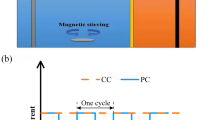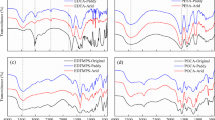Abstract
Ethylenediaminetetraaceticacid (EDTA) has been proven to be an efficient soil washing liquid to remove metal contaminants from soils. However, EDTA may cause secondary pollution due to its low biodegradability if it is not recycled or destroyed in the washing process. Thus, it is necessary to recycle and recover EDTA for sustainable use. In this paper, the extracting performance of fresh EDTA was firstly studied as a function of EDTA concentration, liquid/sediment (L/S) ratio and pH of the solution, and also extraction time. Then sodium tetraethylenepentamine-multi dithiocarbamate (TEPA-DTC), a heavy metals capturing agent, was synthesized on the base of the research of LIU-Lihua. Compared with Na2S and DDTC, TEPA-DTC shows strong chelating capacity, because it has functional groups of dithiocarbamate that could strongly chelate heavy metals and capture metal ions from Me-EDTA to form precipitates, allowing us to reclaim the EDTA during the process of soil washing. Three divalent heavy metals were investigated (Pb, Cd, and Cu). These three metals could almost precipitate completely with TEPA-DTC under the dosage of 300 mg/l, and EDTA was regenerated. The recovered EDTA was used again in three cycles of soil washing, and the amount of heavy metals extracted just slightly decreased each cycle.








Similar content being viewed by others
References
Ali H, Khan E, Sajad MA (2013) Phytoremediation of heavy metals—concepts and applications. Chemosphere 91:869–881
Arevalo E, Stichnothe H, Thöming J, Calmano W (2002) Evaluation of a leaching process coupled with regeneration/recycling of the extractant for treatment of heavy metal contaminated solids. Environ Technol 23:571–581
Bolan NS, Adriano D, Duraisamy P, Mani A, Arulmozhiselvan K (2003a) Immobilization and phytoavailability of cadmium in variable charge soils. I. Effect of phosphate addition. Plant Soil 250:83–94
Bolan NS, Adriano D, Mani P, Duraisamy A (2003b) Immobilization and phytoavailability of cadmium in variable charge soils. II. Effect of lime addition. Plant Soil 251:187–198
Brown DA, Glass WK, Burke MA (1976) The general use of IR spectral criteria in discussions of the bonding and structure of metal dithiocarbamates[J]. Spectrochim Acta Part A Mol Spectrosc 32(1):137–143
Contin M, Mondini C, Leita L, De Nobili M (2007) Enhanced soil toxic metal fixation in iron (hydr) oxides by redox cycles. Geoderma 140:164–175
Dermont G, Bergeron M, Mercier G, Richer-Laflèche M (2008) Soil washing for metal removal: a review of physical/chemical technologies and field applications. J Hazard Mater 152:1–31
Di Palma L, Ferrantelli P (2005) Copper leaching from a sandy soil: mechanism and parameters affecting EDTA extraction. J Hazard Mater 122:85–90
Di Palma L, Mecozzi R (2007) Heavy metals mobilization from harbour sediments using EDTA and citric acid as chelating agents. J Hazard Mater 147:768–775
European Commission (2012) State of soil in Europe. Outlook. http://dx.doi.org/10.2788/77361
Finzgar N, Lestan D (2008) The two-phase leaching of Pb, Zn and Cd contaminated soil using EDTA and electrochemical treatment of the washing solution. Chemosphere 73:1484–1491
Fu F, Zeng H, Cai Q, Qiu R, Yu J, Xiong Y (2007) Effective removal of coordinated copper from wastewater using a new dithiocarbamate-type supramolecular heavy metal precipitant. Chemosphere 69:1783–1789
Juang R-S, Wang S-W (2000) Metal recovery and EDTA recycling from simulated washing effluents of metal-contaminated soils. Water Res 34:3795–3803
Kari FG, Giger W (1996) Speciation and fate of ethylenediaminetetraacetate (EDTA) in municipal wastewater treatment. Water Res 30:122–134
Kumar PN, Dushenkov V, Motto H, Raskin I (1995) Phytoextraction: the use of plants to remove heavy metals from soils. Environ Sci Technol 29:1232–1238
Kumpiene J, Lagerkvist A, Maurice C (2007) Stabilization of Pb-and Cu-contaminated soil using coal fly ash and peat. Environ Pollut 145:365–373
Kumpiene J, Lagerkvist A, Maurice C (2008) Stabilization of As, Cr, Cu, Pb and Zn in soil using amendments—a review. Waste Manag 28:215–225
Lee CC, Marshall WD (2002) Recycling of complexometric extractants to remediate a soil contaminated with heavy metals. J Environ Monitor 4:325–329
Liu L-H, Wu J, Li X, Ling Y-L (2011) Synthesis of a Sodion Tetraethylenepentamine-multi Dithiocarbamate and Its Removal Performance for Heavy Metals. Res Environ Sci 24(3):332–339
Lim T-T, Tay J-H, Wang J-Y (2004) Chelating-agent-enhanced heavy metal extraction from a contaminated acidic soil. J Environ Eng 130:59–66
Lim T-T, Chui P-C, Goh K-H (2005) Process evaluation for optimization of EDTA use and recovery for heavy metal removal from a contaminated soil. Chemosphere 58:1031–1040
Liu C, Evett JB (1984) Soil properties: testing, measurement and evaluation. Prentice-Hall Inc
Lo IM, Zhang W (2006) EDTA-enhanced washing for remediation of Pb and or Zn contaminated soils. J Environ Eng 132:1282–1288
Ministry of Environmental Protection, Ministry of Land and Resources, National Soil Pollution Survey Report (2014). http://www.zhb.gov.cn/gkml/hbb/qt/201404/W020140417558995804588.pdf
Mulligan CN, Yong RN, Gibbs BF (1999) Removal of heavy metals from contaminated soil and sediments using the biosurfactant surfactin. J Soil Contam 8:231–254
Mulligan CN, Yong RN, Gibbs BF (2001) Heavy metal removal from sediments by biosurfactants. J Hazard Mater 85:111–125
Neale CN, Bricka R, Chao AC (1997) Evaluating acids and chelating agents for removing heavy metals from contaminated soils. Environ Prog 16:274–280
Panagos P, Van Liedekerke M, Yigini Y, Montanarella L (2013) Contaminated sites in Europe: review of the current situation based on data collected through a European network. J Environ Public Health 2013:158764. doi:10.1155/2013/158764
Peters RW (1999) Chelant extraction of heavy metals from contaminated soils. J Hazard Mater 66:151–210
Pociecha M, Lestan D (2012) Recycling of EDTA solution after soil washing of Pb, Zn, Cd and As contaminated soil. Chemosphere 86:843–846
Rafati M, Khorasani N, Moattar F, Shirvany A, Moraghebi F, Hosseinzadeh S (2011) Phytoremediation potential of Populus alba and Morus alba for cadmium, chromuim and nickel absorption from polluted soil. International Journal of Environmental Research 5:961–970
Sekara A, Poniedzialeek M, Ciura J, Jedrszczyk E (2005) Cadmium and lead accumulation and distribution in the organs of nine crops: implications for phytoremediation. Pol J Environ Stud 14:509–516
Sun B, Zhao F, Lombi E, McGrath S (2001) Leaching of heavy metals from contaminated soils using EDTA. Environ Pollut 113:111–120
Tessier A, Campbell PG, Bisson M (1979) Sequential extraction procedure for the speciation of particulate trace metals. Anal Chem 51:844–851
Udovic M, Lestan D (2012) EDTA and HCl leaching of calcareous and acidic soils polluted with potentially toxic metals: remediation efficiency and soil impact. Chemosphere 88:718–724
U.S. EPA, Method 3051A (1998) Microwave assisted acid digestion of sediments, sludges, soils, and oils. http://www.epa.gov/epawaste/hazard/testmethods/sw846/pdfs/3051a.pdf
Voglar D, Lestan D (2013) Pilot-scale washing of Pb, Zn and Cd contaminated soil using EDTA and process water recycling. Chemosphere 91:76–82
Walkley A, Black IA (1934) An examination of the Degtjareff method for determining soil organic matter, and a proposed modification of the chromic acid titration method. Soil Sci 37:29–38
Wasay S, Barrington S, Tokunaga S (2001) Organic acids for the in situ remediation of soils polluted by heavy metals: soil flushing in columns. Water Air Soil Pollut 127:301–314
Wu Q, Wang S, Thangavel P, Li Q, Zheng H, Bai J, Qiu R (2011) Phytostabilization potential of Jatropha curcas L. in polymetallic acid mine tailings. Int J Phytoremediation 13:788–804
Wuana R, Okieimen F, Imborvungu J (2010) Removal of heavy metals from a contaminated soil using organic chelating acids. Int J Environ Sci Technol 7:485–496
Zhang S, Li T, Huang H, Zou T, Zhang X, Yu H, Zheng Z, Wang Y (2012) Cd accumulation and phytostabilization potential of dominant plants surrounding mining tailings. Environ Sci Pollut Res 19:3879–3888
Zhen H-B, Xu Q, Hu Y-Y, Cheng J-H (2012) Characteristics of heavy metals capturing agent dithiocarbamate (DTC) for treatment of ethylene diamine tetraacetic acid–Cu (EDTA–Cu) contaminated wastewater. Chem Eng J 209:547–557
Zou T, Li T, Zhang X, Yu H, Huang H (2012) Lead accumulation and phytostabilization potential of dominant plant species growing in a lead–zinc mine tailing. Environ Earth Sci 65:621–630
Acknowledgements
The author is sincerely thankful to the State Key Laboratory of Pollution Control and Resource Reuse for instrumental support. This work was funded by “Stability properties and mechanism research of chelating group functionalized dentritic polymers on heavy metals in municipal solid waste incineration fly ash” program (21577100), National Natural Science Foundation of China.
Author information
Authors and Affiliations
Corresponding author
Rights and permissions
About this article
Cite this article
Wang, Y., Zhang, B., Deng, T. et al. Reclamation of EDTA by sodium tetraethylenepentamine-multi dithiocarbamate after soil washing process with EDTA. Environ Earth Sci 76, 311 (2017). https://doi.org/10.1007/s12665-017-6587-8
Received:
Accepted:
Published:
DOI: https://doi.org/10.1007/s12665-017-6587-8




